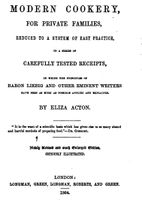To Choose Veal
By Eliza Acton
Published 1845
Veal should be fat, finely grained, white, firm, and not overgrown: for when very large it is apt to be coarse and tough. It is more difficult to keep than any other meat except pork, and should never be allowed to acquire the slightest taint before it is dressed, as any approach to putridity renders it equally unwholesome and offensive to the taste. The fillet, the loin, the shoulder, and the best end of the neck, are the parts generally selected for roasting; the breast and knuckle are more usually stewed or boiled, although the former is excellent roasted. The udder or firm white fat of the fillet, is much used by French cooks instead of butter, in the composition of their forcemeats: for these, it is first well boiled, then left until write cold, and afterwards thoroughly pounded before it is mixed with the other ingredients. The head and feet of the calf are valuable articles of food, both for the nutriment which the gelatinous parts of them afford, and for the great variety of modes in which they may be dressed. The kidneys, with the rich fat that surrounds them, and the sweetbreads, are well known delicacies; the liver and the heart also are very good eating; and no meat is so generally useful for rich soups and gravies as veal.
Become a Premium Member to access this page
Unlimited, ad-free access to hundreds of the world’s best cookbooks
Over 160,000 recipes with thousands more added every month
Recommended by leading chefs and food writers
Powerful search filters to match your tastes
Create collections and add reviews or private notes to any recipe
Swipe to browse each cookbook from cover-to-cover
Manage your subscription via the My Membership page
Part of
Advertisement
Advertisement


